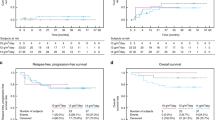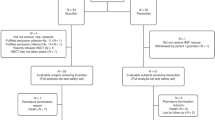Abstract
We conducted a phase I trial to determine the maximum tolerated dose (MTD) of clofarabine with high-dose busulfan followed by allogeneic stem cell transplantation (SCT) in patients with high-risk and refractory acute leukemia. Patients received intravenous busulfan 0.8 mg/kg every 6 h on days −6 to −3 and clofarabine 30–60 mg/m2 per day on days −6 to −2. Graft-versus-host disease prophylaxis included sirolimus plus tacrolimus (days −2 to +180). A total of 15 patients, median age 48 (30–58) years, with acute leukemia that was relapsed and refractory (n=8), primary refractory (n=6), or in CR2 (n=1), were treated at four clofarabine dose levels: 30 (n=3), 40 (n=3), 50 (n=3) and 60 mg/m2 per day (n=6) with busulfan. All engrafted, and the MTD was not reached. Grades 3–4 non-hematological toxicities included vomiting (n=3), mucositis (n=9), hand-foot syndrome (n=1), acute renal failure (n=1) and reversible elevation of aspartate aminotransferase/alanine aminotransferase (n=10). The 1-year event-free survival was 53% (95% confidence interval: 33–86%), and the 1-year overall survival was 60% (95% confidence interval: 40–91%). Given the good tolerability and promising results, we recommend clofarabine 60 mg/m2 per day × 5 days as a phase II dose in combination with busulfan (12.8 mg per kg total dose) for further study as a myeloablative regimen for allogeneic SCT for high-risk acute leukemia.
This is a preview of subscription content, access via your institution
Access options
Subscribe to this journal
Receive 12 print issues and online access
$259.00 per year
only $21.58 per issue
Buy this article
- Purchase on Springer Link
- Instant access to full article PDF
Prices may be subject to local taxes which are calculated during checkout


Similar content being viewed by others
References
Moore J, Nivison-Smith I, Goh K, Ma D, Bradstock K, Szer J et al. Equivalent survival for sibling and unrelated donor allogeneic stem cell transplantation for acute myelogenous leukemia. Biol Blood Marrow Transplant 2007; 13: 601–607.
Tomblyn MB, Arora M, Baker KS, Blazar BR, Brunstein CG, Burns LJ et al. Myeloablative hematopoietic cell transplantation for acute lymphoblastic leukemia: analysis of graft sources and long-term outcome. J Clin Oncol 2009; 27: 3634–3641.
Aoudjhane M, Labopin M, Gorin NC, Shimoni A, Ruutu T, Kolb HJ et al. Comparative outcome of reduced intensity and myeloablative conditioning regimen in HLA identical sibling allogeneic haematopoietic stem cell transplantation for patients older than 50 years of age with acute myeloblastic leukaemia: a retrospective survey from the Acute Leukemia Working Party (ALWP) of the European group for Blood and Marrow Transplantation (EBMT). Leukemia 2005; 19: 2304–2312.
de Lima M, Anagnostopoulos A, Munsell M, Shahjahan M, Ueno N, Ippoliti C et al. Nonablative versus reduced-intensity conditioning regimens in the treatment of acute myeloid leukemia and high-risk myelodysplastic syndrome: dose is relevant for long-term disease control after allogeneic hematopoietic stem cell transplantation. Blood 2004; 104: 865–872.
Hartman AR, Williams SF, Dillon JJ . Survival, disease-free survival and adverse effects of conditioning for allogeneic bone marrow transplantation with busulfan/cyclophosphamide vs total body irradiation: a meta-analysis. Bone Marrow Transplant 1998; 22: 439–443.
McDonald GB, Slattery JT, Bouvier ME, Ren S, Batchelder AL, Kalhorn TF et al. Cyclophosphamide metabolism, liver toxicity, and mortality following hematopoietic stem cell transplantation. Blood 2003; 101: 2043–2048.
Slattery JT, Kalhorn TF, McDonald GB, Lambert K, Buckner CD, Bensinger WI et al. Conditioning regimen-dependent disposition of cyclophosphamide and hydroxycyclophosphamide in human marrow transplantation patients. J Clin Oncol 1996; 14: 1484–1494.
Ulrickson M, Aldridge J, Kim HT, Hochberg EP, Hammerman P, Dube C et al. Busulfan and cyclophosphamide (Bu/Cy) as a preparative regimen for autologous stem cell transplantation in patients with non-Hodgkin lymphoma: a single-institution experience. Biol Blood Marrow Transplant 2009; 15: 1447–1454.
Santos GW . The development of busulfan/cyclophosphamide preparative regimens. Semin Oncol 1993; 20: 12–16.
Andersson BS, de Lima M, Thall PF, Wang X, Couriel D, Korbling M et al. Once daily i.v. busulfan and fludarabine (i.v. Bu-Flu) compares favorably with i.v. busulfan and cyclophosphamide (i.v. BuCy2) as pretransplant conditioning therapy in AML/MDS. Biol Blood Marrow Transplant 2008; 14: 672–684.
Williams CB, Day SD, Reed MD, Copelan EA, Bechtel T, Leather HL et al. Dose modification protocol using intravenous busulfan (Busulfex) and cyclophosphamide followed by autologous or allogeneic peripheral blood stem cell transplantation in patients with hematologic malignancies. Biol Blood Marrow Transplant 2004; 10: 614–623.
Bornhauser M, Storer B, Slattery JT, Appelbaum FR, Deeg HJ, Hansen J et al. Conditioning with fludarabine and targeted busulfan for transplantation of allogeneic hematopoietic stem cells. Blood 2003; 102: 820–826.
de Lima M, Couriel D, Thall PF, Wang X, Madden T, Jones R et al. Once-daily intravenous busulfan and fludarabine: clinical and pharmacokinetic results of a myeloablative, reduced-toxicity conditioning regimen for allogeneic stem cell transplantation in AML and MDS. Blood 2004; 104: 857–864.
Keating MJ, Estey E, O’Brien S, Kantarjian H, Robertson LE, Plunkett W . Clinical experience with fludarabine in leukaemia. Drugs 1994; 47 (Suppl 6): 39–49.
Bonate PL, Arthaud L, Cantrell Jr WR, Stephenson K, Secrist III JA, Weitman S . Discovery and development of clofarabine: a nucleoside analogue for treating cancer. Nat Rev Drug Discov 2006; 5: 855–863.
Jeha S, Gaynon PS, Razzouk BI, Franklin J, Kadota R, Shen V et al. Phase II study of clofarabine in pediatric patients with refractory or relapsed acute lymphoblastic leukemia. J Clin Oncol 2006; 24: 1917–1923.
Kantarjian H, Gandhi V, Cortes J, Verstovsek S, Du M, Garcia-Manero G et al. Phase 2 clinical and pharmacologic study of clofarabine in patients with refractory or relapsed acute leukemia. Blood 2003; 102: 2379–2386.
Kantarjian HM, Gandhi V, Kozuch P, Faderl S, Giles F, Cortes J et al. Phase I clinical and pharmacology study of clofarabine in patients with solid and hematologic cancers. J Clin Oncol 2003; 21: 1167–1173.
Burnett AK, Russell NH, Kell J, Dennis M, Milligan D, Paolini S et al. European development of clofarabine as treatment for older patients with acute myeloid leukemia considered unsuitable for intensive chemotherapy. J Clin Oncol 2010; 28: 2389–2395.
Kantarjian HM, Erba HP, Claxton D, Arellano M, Lyons RM, Kovascovics T et al. Phase II study of clofarabine monotherapy in previously untreated older adults with acute myeloid leukemia and unfavorable prognostic factors. J Clin Oncol 2010; 28: 549–555.
Yamauchi T, Nowak BJ, Keating MJ, Plunkett W . DNA repair initiated in chronic lymphocytic leukemia lymphocytes by 4-hydroperoxycyclophosphamide is inhibited by fludarabine and clofarabine. Clin Cancer Res 2001; 7: 3580–3589.
Atkinson K, Horowitz MM, Gale RP, Lee MB, Rimm AA, Bortin MM . Consensus among bone marrow transplanters for diagnosis, grading and treatment of chronic graft-versus-host disease. Committee of the International Bone Marrow Transplant Registry. Bone Marrow Transplant 1989; 4: 247–254.
Przepiorka D, Weisdorf D, Martin P, Klingemann HG, Beatty P, Hows J et al. 1994 consensus conference on acute GVHD grading. Bone Marrow Transplant 1995; 15: 825–828.
Nakamura Y, Leppert M, O’Connell P, Wolff R, Holm T, Culver M et al. Variable number of tandem repeat (VNTR) markers for human gene mapping. Science 1987; 235: 1616–1622.
Dohner H, Estey EH, Amadori S, Appelbaum FR, Buchner T, Burnett AK et al. Diagnosis and management of acute myeloid leukemia in adults: recommendations from an international expert panel, on behalf of the European LeukemiaNet. Blood 2010; 115: 453–474.
Cooper T, Kantarjian H, Plunkett W, Gandhi V . Clofarabine in adult acute leukemias: clinical success and pharmacokinetics. Nucleosides Nucleotides Nucleic Acids 2004; 23: 1417–1423.
Slattery JT, Risler LJ . Therapeutic monitoring of busulfan in hematopoietic stem cell transplantation. Ther Drug Monit 1998; 20: 543–549.
Parker WB, Shaddix SC, Chang CH, White EL, Rose LM, Brockman RW et al. Effects of 2-chloro-9-(2-deoxy-2-fluoro-beta-D-arabinofuranosyl)adenine on K562 cellular metabolism and the inhibition of human ribonucleotide reductase and DNA polymerases by its 5′-triphosphate. Cancer Res 1991; 51: 2386–2394.
Xie KC, Plunkett W . Deoxynucleotide pool depletion and sustained inhibition of ribonucleotide reductase and DNA synthesis after treatment of human lymphoblastoid cells with 2-chloro-9-(2-deoxy-2-fluoro-beta-D-arabinofuranosyl) adenine. Cancer Res 1996; 56: 3030–3037.
Genini D, Budihardjo I, Plunkett W, Wang X, Carrera CJ, Cottam HB et al. Nucleotide requirements for the in vitro activation of the apoptosis protein-activating factor-1-mediated caspase pathway. J Biol Chem 2000; 275: 29–34.
Genini D, Adachi S, Chao Q, Rose DW, Carrera CJ, Cottam HB et al. Deoxyadenosine analogs induce programmed cell death in chronic lymphocytic leukemia cells by damaging the DNA and by directly affecting the mitochondria. Blood 2000; 96: 3537–3543.
Srivastava S, Jones D, Wood LL, Schwartz JE, Nelson Jr RP, Abonour R et al. A phase I trial of high-dose clofarabine, etoposide and cyclophosphamide and autologous peripheral blood stem cell transplantation in patients with primary refractory and relapsed and refractory non-Hodgkin's lymphoma. Biol Blood Marrow Transplant 2010; (E-pub ahead of print 20 October 2010).
McGregor BA, Brown AW, Osswald MB, Savona MR . The use of higher dose clofarabine in adults with relapsed acute lymphoblastic leukemia. Am J Hematol 2009; 84: 228–230.
Andersson BS, Valdez BC, de Lima M, Wang X, Thall PF, Worth LL et al. Clofarabine+/−fludarabine with once daily IV Busulfan as pretransplant conditioning therapy for advanced myeloid leukemia and MDS. Biol Blood Marrow Transplant 2010; (E-pub ahead of print 11 October 2010).
Martin MG, Uy GL, Procknow E, Stockerl-Goldstein K, Cashen A, Westervelt P et al. Allo-SCT conditioning for myelodysplastic syndrome and acute myeloid leukemia with clofarabine, cytarabine and ATG. Bone Marrow Transplant 2009; 44: 13–17.
Grigg AP, Szer J, Beresford J, Dodds A, Bradstock K, Durrant S et al. Factors affecting the outcome of allogeneic bone marrow transplantation for adult patients with refractory or relapsed acute leukaemia. Br J Haematol 1999; 107: 409–418.
Oyekunle AA, Kroger N, Zabelina T, Ayuk F, Schieder H, Renges H et al. Allogeneic stem-cell transplantation in patients with refractory acute leukemia: a long-term follow-up. Bone Marrow Transplant 2006; 37: 45–50.
Schmid C, Schleuning M, Ledderose G, Tischer J, Kolb HJ . Sequential regimen of chemotherapy, reduced-intensity conditioning for allogeneic stem-cell transplantation, and prophylactic donor lymphocyte transfusion in high-risk acute myeloid leukemia and myelodysplastic syndrome. J Clin Oncol 2005; 23: 5675–5687.
Acknowledgements
This study was supported in part by research funding from Genzyme Inc. Pharmacoanalytical work was performed by the Clinical Pharmacology Analytical Laboratory of the Indiana University Melvin and Bren Simon Cancer Center and supported by Institutional grant P30 CA082709.
Author information
Authors and Affiliations
Corresponding author
Ethics declarations
Competing interests
SF has received research support from Genzyme Inc., and Honoraria from Genzyme Inc. and Otsuka Pharmaceuticals.
Rights and permissions
About this article
Cite this article
Farag, S., Wood, L., Schwartz, J. et al. Phase I trial and pharmacokinetic study of high-dose clofarabine and busulfan and allogeneic stem cell transplantation in adults with high-risk and refractory acute leukemia. Leukemia 25, 599–605 (2011). https://doi.org/10.1038/leu.2010.319
Received:
Revised:
Accepted:
Published:
Issue Date:
DOI: https://doi.org/10.1038/leu.2010.319
Keywords
This article is cited by
-
Minimal residual disease monitoring and preemptive immunotherapies for frequent 11q23 rearranged acute leukemia after allogeneic hematopoietic stem cell transplantation
Annals of Hematology (2021)
-
A multicenter trial of myeloablative clofarabine and busulfan conditioning for relapsed or primary induction failure AML not in remission at the time of allogeneic hematopoietic stem cell transplantation
Bone Marrow Transplantation (2017)
-
Clinical pharmacology and clinical trials of ribonucleotide reductase inhibitors: is it a viable cancer therapy?
Journal of Cancer Research and Clinical Oncology (2017)
-
New drug toxicities in the onco-nephrology world
Kidney International (2015)
-
Feasibility of clofarabine cytoreduction followed by haploidentical hematopoietic stem cell transplantation in patients with relapsed or refractory advanced acute leukemia
Annals of Hematology (2013)



